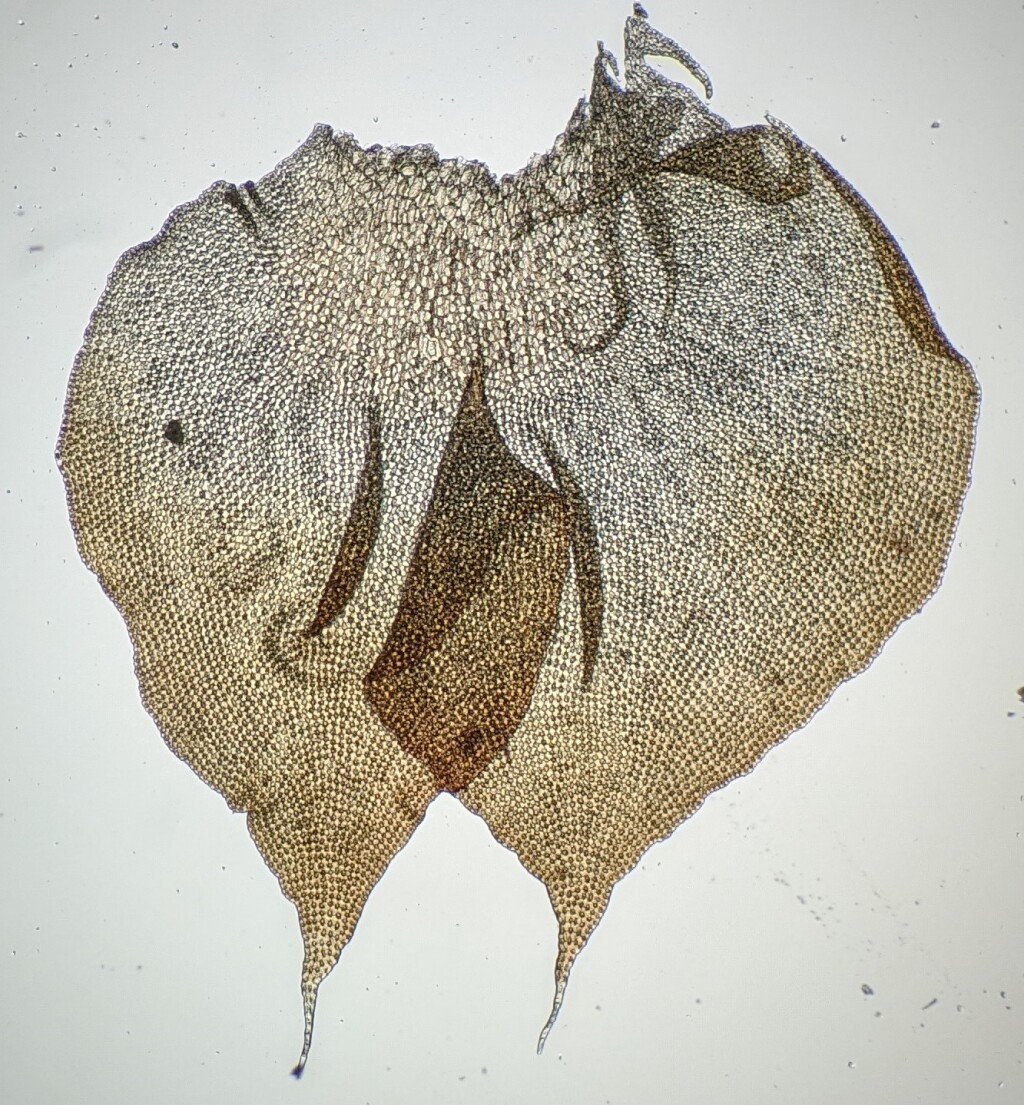Chandonanthus
Terrestrial, lithophytic or epiphytic, dioecious. Specialised asexual propagules absent. Stems erect to pendulous, sparingly branched, with two ranks of lateral leaves, a single rank of underleaves and abundant paraphyllia; branches emerging from main stem near abaxial side of unlobed lateral leaf and without a collar of tissue at base, or laterally or from ventral side of stem and with a collar of tissue at base. Lateral leaves truncate-ovate in outline, bilobed for around half leaf length, succubous, alternate, imbricate, undulate, laciniate at base, otherwise entire; lobes ovate, acuminate, overlapping when flattened. Underleaves deeply bilobed, up to half the size of lateral leaves, imbricate, with several cilia scattered along margin; lobes ovate to lanceolate, divergent, with attenuate apices. Leaf cells irregular, pluripapillose, thin-walled, with large and usually confluent trigones that when all combined occupy most of leaf area, mostly with 5–6 oil bodies; oil bodies elliptic or ovoid to spherical, granulate. Paraphyllia filiform to lanceolate, entire, ciliate or dentate. Rhizoids confined to stem bases. Androecia intercalary, composed of leaf-like but less divided lateral bracts, each with 2–3 antheridia, and bracteoles without antheridia. Sporophyte terminal on stem or branch, developing in a perianth; perianth ellipsoid, pluriplicate for most of its length, with ciliate to laciniate mouth and paraphyllia at base; capsule ellipsoid, 7–8-stratose; elaters bispiral; spores globose, granulate.
One species, C. squarrosus (Hook.) Mitt., from New Zealand, Tasmania and Victoria.
Chandonanthus was tentatively placed in the Anastrophyllaceae by Söderström et al. (2016), with the acknowledgement that its placement requires confirmation with molecular methods. Phylogenetic analyses of chloroplast DNA sequences have since placed material identified as Chandonanthus squarrosus in Adelanthaceae (Katagiri & Inoue 2018). Consequently, Chandonanthus is included in the Adelanthaceae here. However, it would be desirable to confirm the identification of this sample and confirm the phylogenetic placement of this species with further samples given that Chandonanthus is a seemingly morphologically discordant member of the Adelanthaceae. Chandonanthus is unique in the Adelanthaceae in having paraphyllose stems and large well-developed underleaves. Chandonanthus do share distinctive capsules with the some of the other Adelanthaceae that are ellipsoid, 7–8-stratose and have two-phase ontogeny of the epidermal cells (Schuster 2002). These last two characters differ in Anastrophyllaceae (Schuster 2002).
Katagiri, T. & Inoue, Y. (2018). Phylogenetic position of the East Asian endemic genus Hattoria (Anastrophyllaceae) based on chloroplast DNA sequences. Hattoria 9: 41–52.
Schuster, R.M. (2002). Austral Hepaticae Part II. Nova Hedwigia Beiheft 119. Cramer in der Gebrüder Borntraeger Verlagsbuchbehandlung: Berling & Stuttgart.
Söderström, L., Hagborg, A., von Konrat, M., Bartholomew-Began, S., Bell, D., Briscoe, L., Brown, E., Cargill, D.C., Costa, D.P., Crandall-Stotler, B.J., Cooper, E.D., Dauphin, G., Engel, J.J., Feldberg, K., Glenny, D., Gradstein, S.R., He, X., Heinrichs, J., Hentschel, J., Ilkiu-Borges, A.L., Katagiri, T., Konstantinova, N.A., Larraín, J., Long, D.G., Nebel, M., Pócs, T., Puche, F., Reiner-Drehwald, E., Renner, M.A.M., Sass-Gyarmati, A., Schäfer-Verwimp, A., Moragues, J.S., Stotler, R.E., Sukkharak, P., Thiers, B.M., Uribe, J., Váňa, J., Villarreal, J.C., Wigginton, M., Zhang, L. & Zhu, R. (2016). World checklist of hornworts and liverworts. Phytokeys 59: 1–828.
 Spinning
Spinning